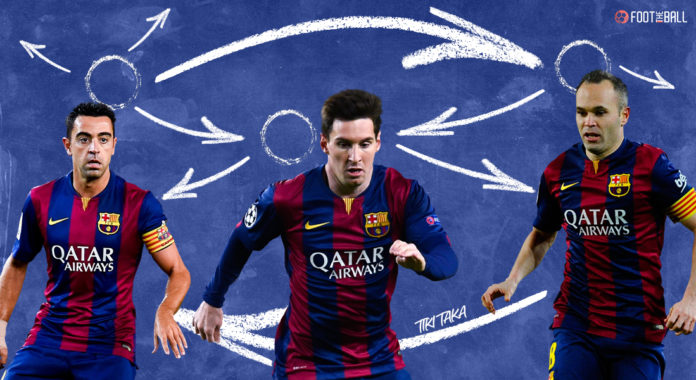In football, many revolutions occurred throughout the last century that shifted the landscape of the game. Tiki-Taka is one such system that not only changed the way the game was played but also produced one of the finest teams in the history of football, dominating the game like no other.
However, the actual implementation of the tactic was a little more complicated. Tiki-taka was the defining legacy of the late-2000s, with seemingly every team wanting to play like that.
Old Barcelona tiki-taka vibes 😲 pic.twitter.com/GW9iAsqm7Z
— ESPN FC (@ESPNFC) October 21, 2021
Of course, there were deficiencies, and neither Barcelona nor Spain managed to last with it for too long. The evolution of tactics saw the rise of many new possibilities. However, tiki-taka would live long in the memory of supporters worldwide as the backbone of Spanish football during its most glorious years.
What is tiki-taka?
The name was coined by the late great Spanish commentator Andres Montes during the 2006 World Cup. Tiki-taka loosely translates to “touch-touch,” which is indicative of how the teams play. Pep Guardiola is credited with being the most successful proponent of the system, but its roots are steeped in history. Tiki-taka is the end product of the evolution of Schalke’s ‘spinning top’ tactic in the 1930s and the school of Total Football in the 1970s.
Johan Cruyff and Pep Guardiola. pic.twitter.com/wjVCrTmriQ
— 90s Football (@90sfootball) November 18, 2020
The Dutch connection is strong with Barcelona, and of course, it is Johan Cruyff, a protege of Rinus Michels, who led the foundation of the modern-day version. Pep Guardiola was one of the players during Cruyff’s managerial reign, who stressed developing La Masia in the mould of the first team. Therefore, when Pep Guardiola arrived, the stage was nicely set for the peak years of his former protegees.
Tiki-taka majorly focused on the passing aspect of the game. It is about using short, quick passes to unlock the opposition’s defensive line patiently. Moreover, tiki-taka also employs through balls to find the runner behind opposing backlines.
The teams emphasized keeping possession for as long as possible but eventually, they had to lose it at times. Then it became all about winning the ball back supremely quick. Barcelona and Spain employed the high press which started with the forwards.
They would try and nick the ball off of the opposing defenders in the attacking half itself. This later became a philosophy on its own, called Gegenpressing. The style is obsolete nowadays as teams have figured out the style by the early-2010s, ironically, by gegenpressing.
Nevertheless, when in full flow nothing came close to beating tiki-taka. Teams were befuddled as to how to work past the rigorous and extremely effective style of passing that left them in the dust.
Read also: How Xavi has affected a monstrous turnaround at Barcelona already
Perfected in Spain, practised worldwide
Pep Guardiola may have perfected tiki-taka to a tee, but he was not alone. Vicente del Bosque, the legendary manager of the Spanish national team, used Barcelona’s tactics during his years in charge of the national team. Spain had a solid core of players from the Blaugrana. Apart from the midfield trio, La Roja had Gerard Pique, Carles Puyol, Jordi Alba, and Pedro.
The school of Barcelona won the sextuple with Guardiola and is regularly considered one of the best teams in history. Spain’s four-year dominance at the top would not have been possible if not for tiki-taka. Several clubs worldwide tried adopting the tactic, but the impact was not the same.
About as dominant as a #passmap can be.
Barcelona's tiki-taka controlled the center of the pitch and dominated territory completely. pic.twitter.com/NoiA4ruelh— 11tegen11 (@11tegen11) February 7, 2017
Barcelona’s quality was too immense to be copied elsewhere. La Masia had perfected the art of tiki-taka which translated smoothly to the senior squad.
Also read: Ruben Amorim is one of the best young managers and ready for next step
Phasing out with time
Needless to say, tiki-taka had a long, fruitful run at the top, but it was never going to last. When it came on the scene, it was all the rage. However, opponents were slowly starting to get the better of the style. Guardiola later would vehemently deny that his Barcelona side played tiki-taka.
Tiki-Taka is 𝐧𝐨 𝐦𝐨𝐫𝐞. 😳 pic.twitter.com/LavylqnTT0
— 90min (@90min_Football) September 21, 2021
“I loathe all that passing for the sake of it, all that tiki-taka. It’s so much rubbish and has no purpose,” Guardiola said in 2014. “You have to pass the ball with a clear intention, to make it into the opposition’s goal. It’s not about passing for the sake of it.”
However, Cruyff, in 2013, spoke glowingly of the Catalans’ style, stating,
“I think the way Barcelona played, it’s a pleasure for everybody who likes football because the technical qualities are the highest standard and every little child can try to do the technical qualities.”
Spain’s dominance at the international level also came to a thudding end at the 2014 World Cup. Barcelona would continue winning silverware, but it was under different styles.
It remains one of the great philosophies in world football. The domination, pervasiveness, and success it brought have been iconic.
*This article is sponsored by Anaptyss, the Perfect blend of People, Process and Technology.




